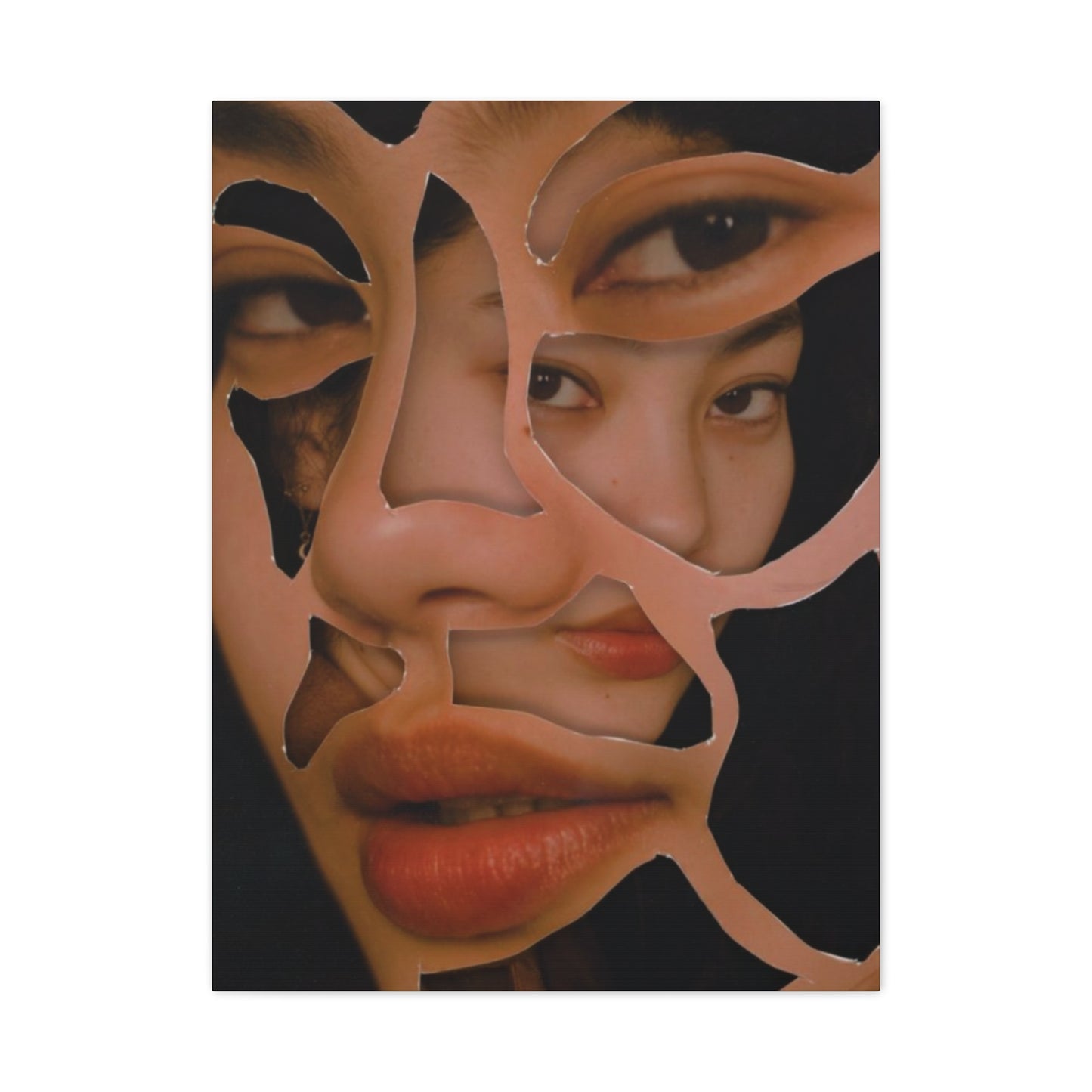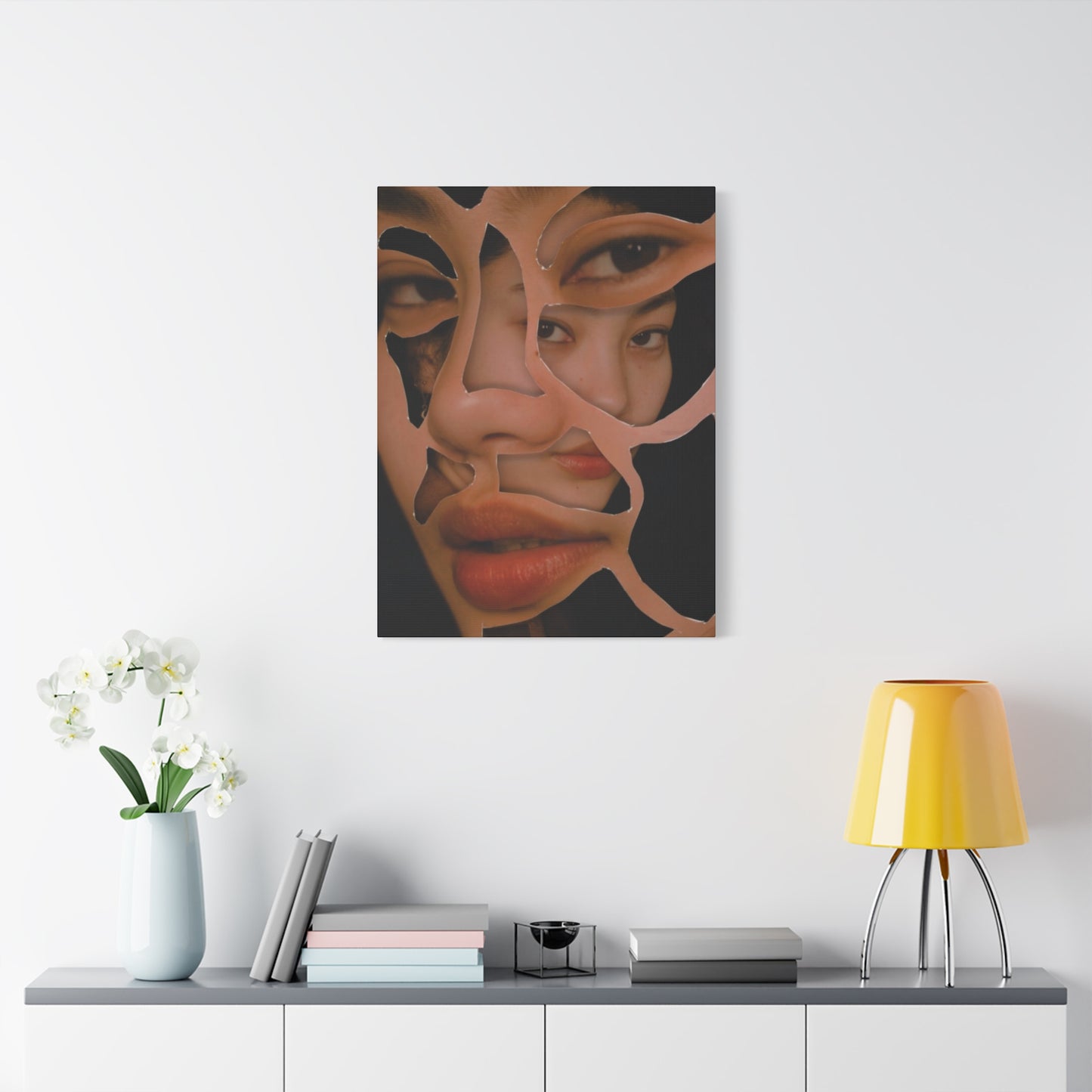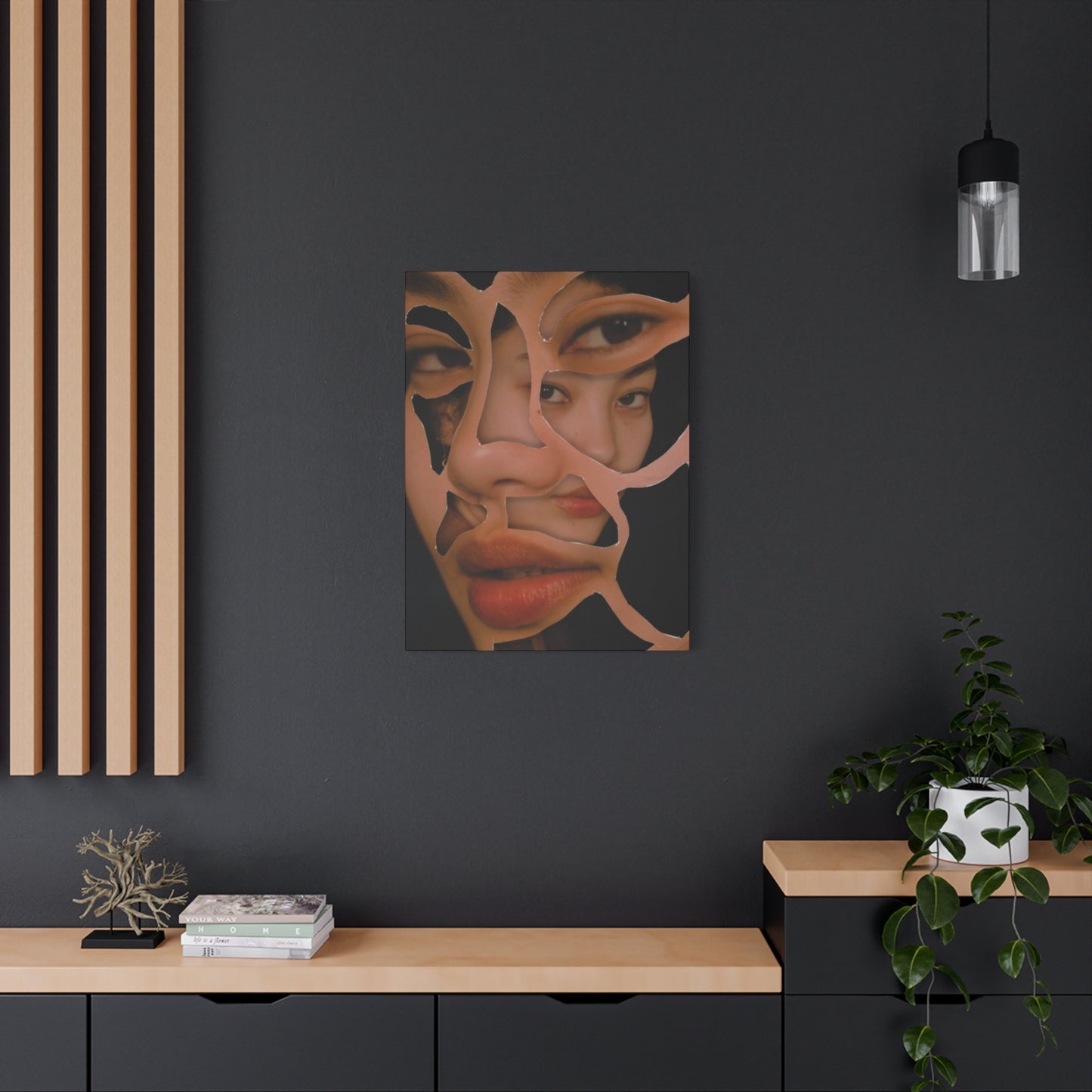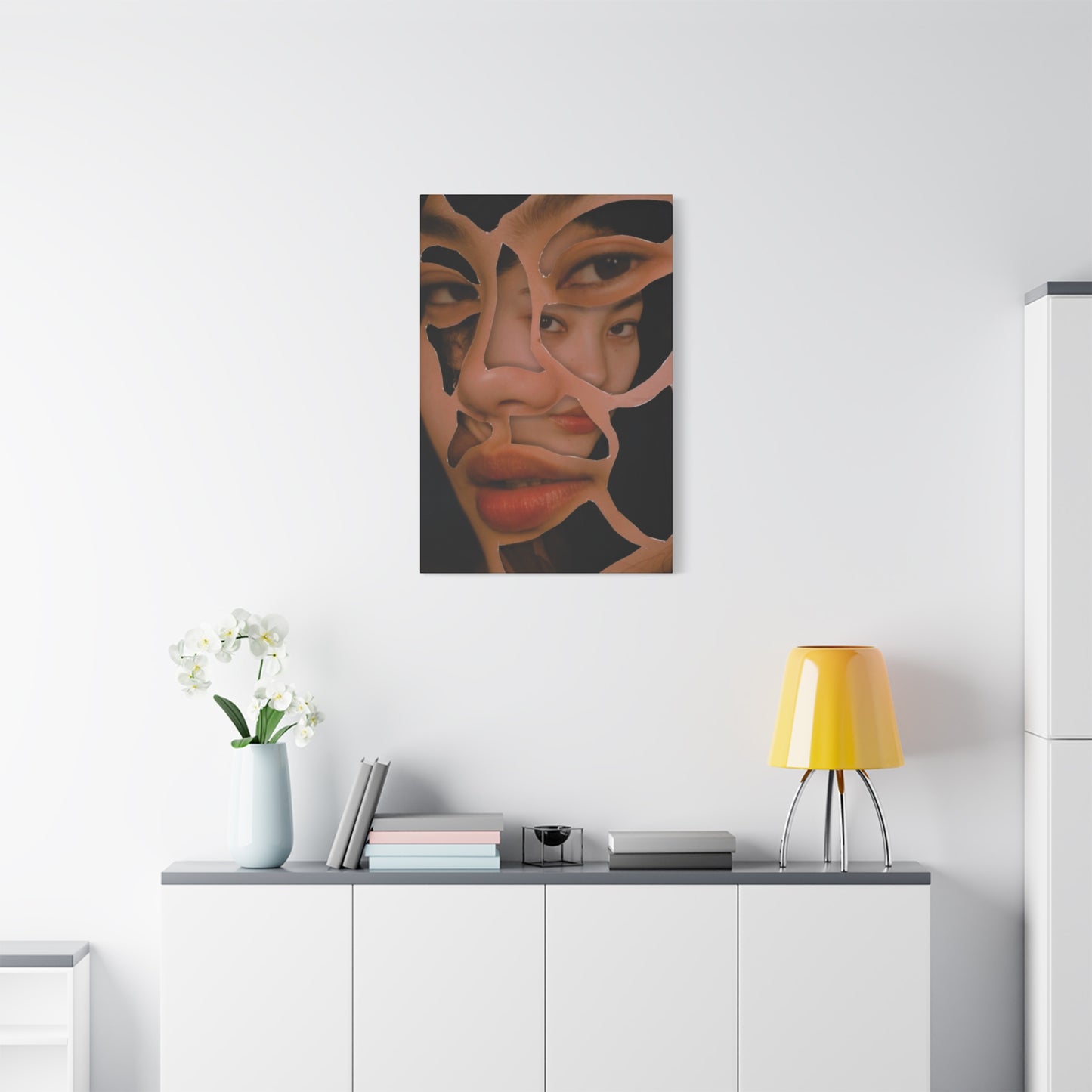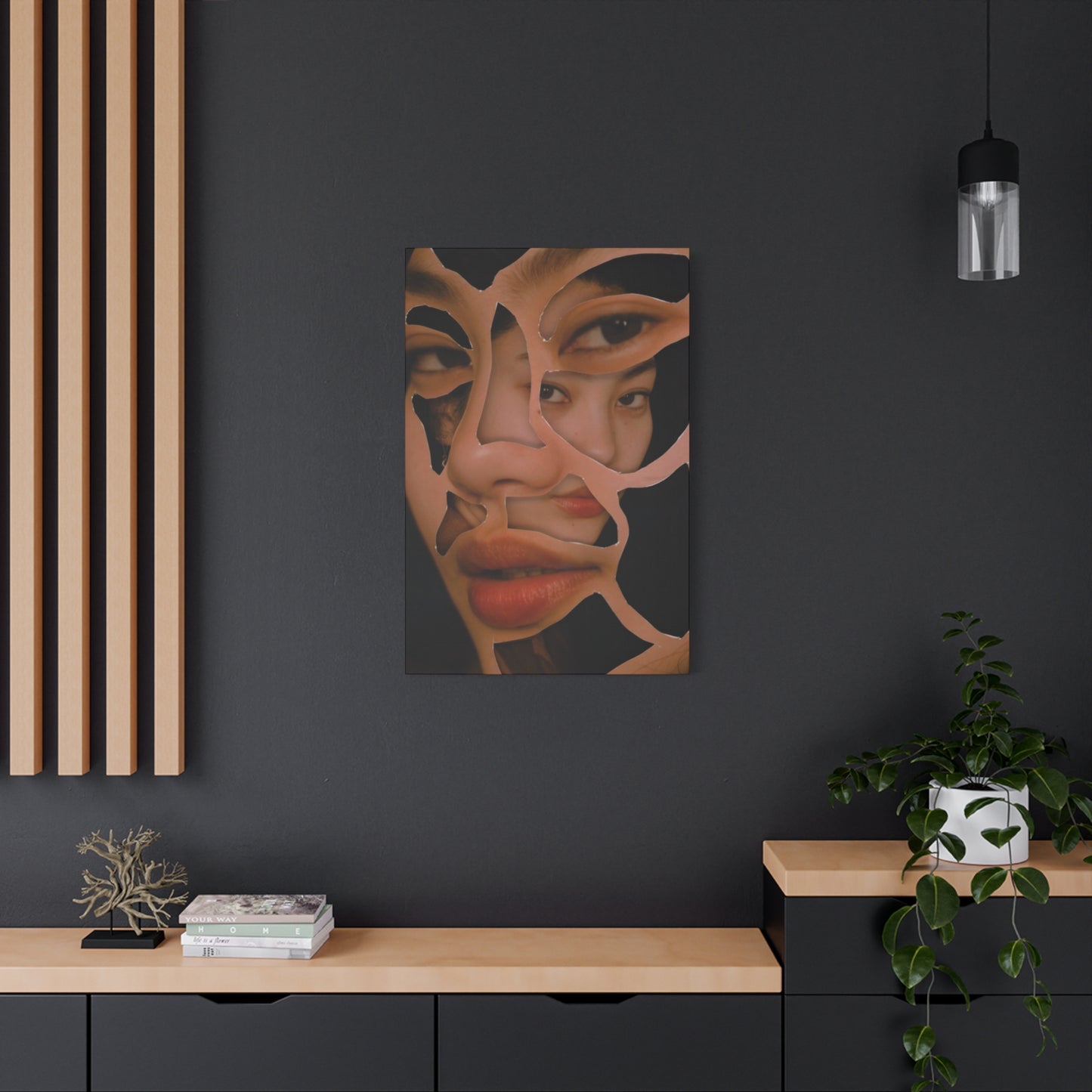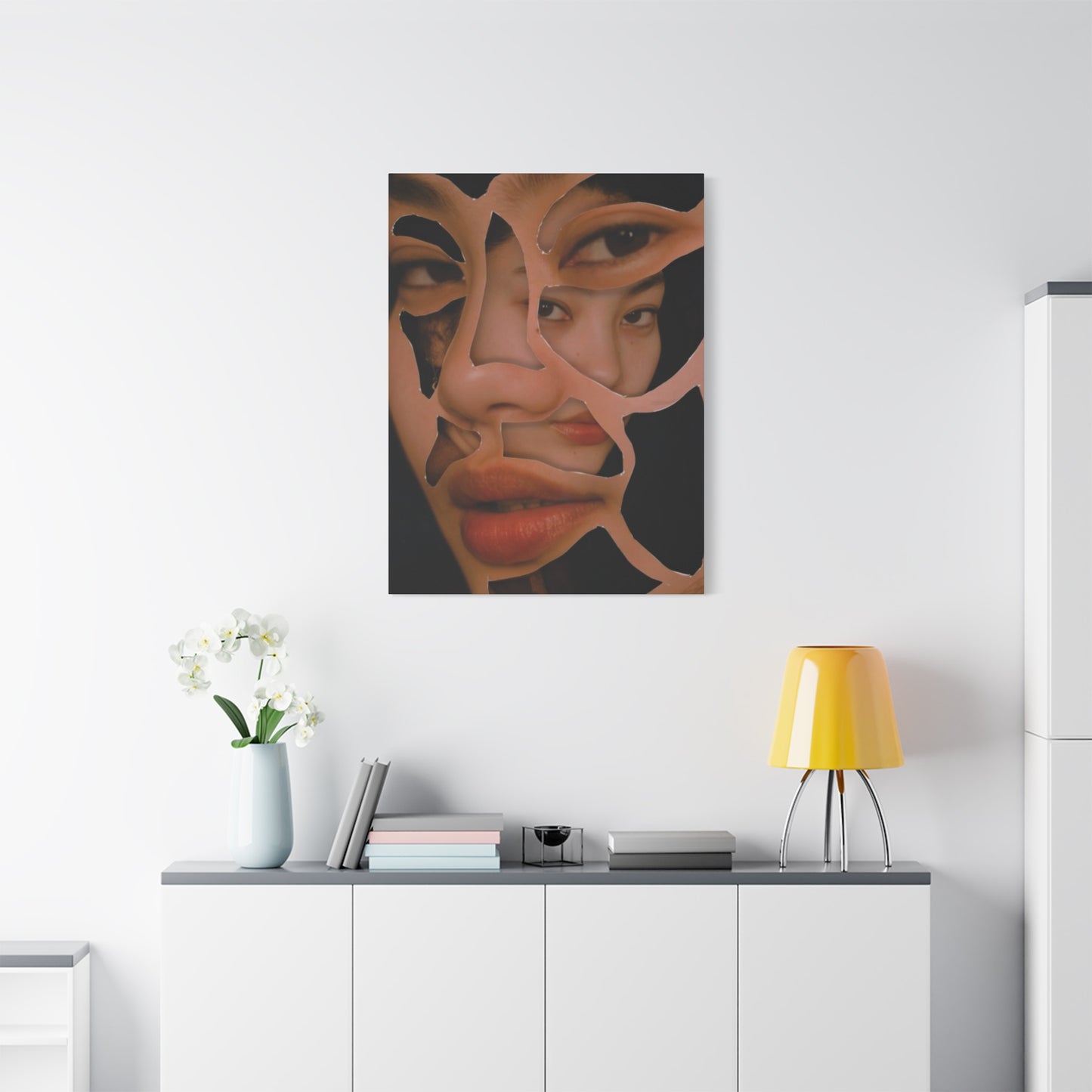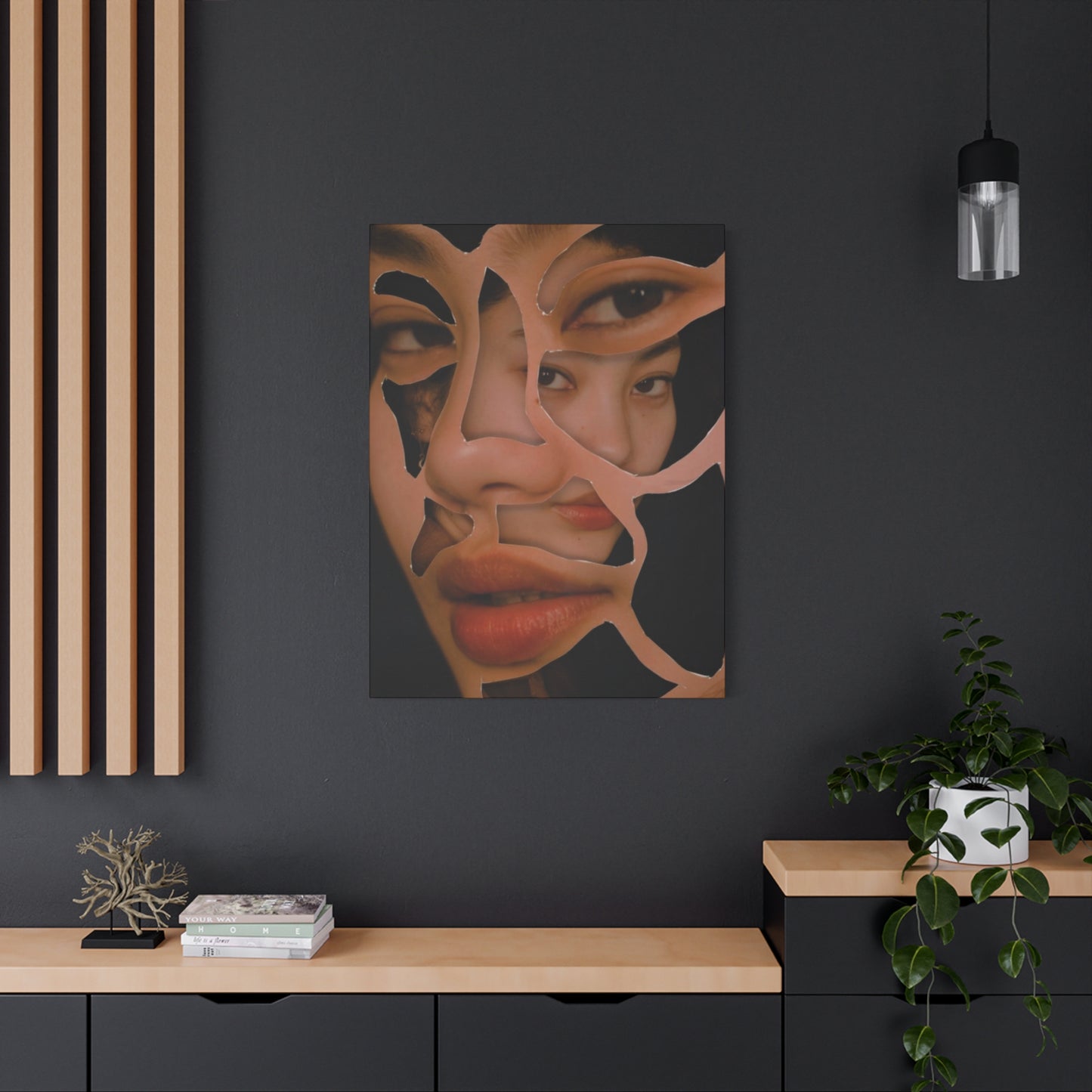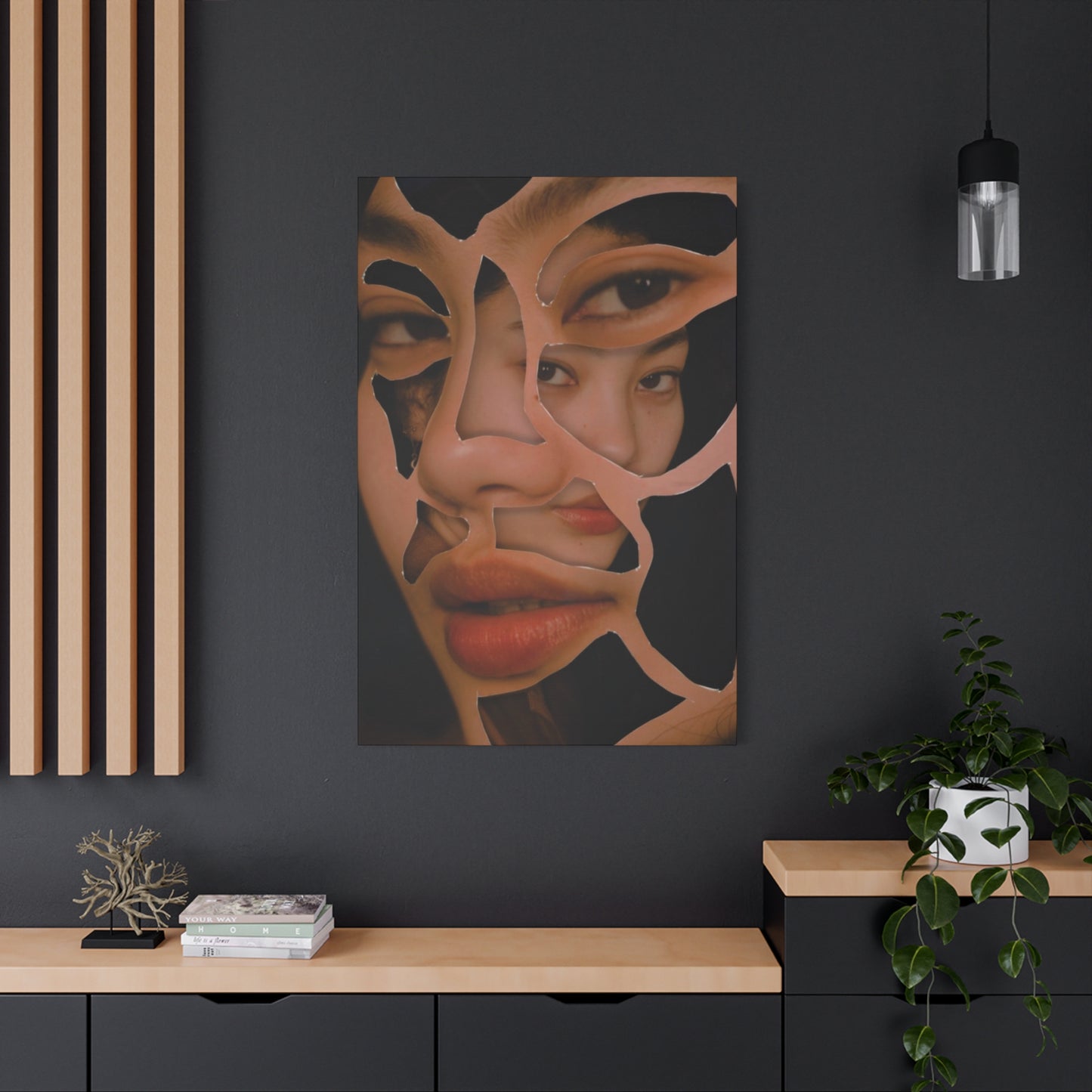Faces Within Faces: Symbolism and the Subconscious in Mixed Media Wall Art
The human face is art's oldest and most powerful subject. It is a landscape of emotion, a map of experience, and the primary vessel of our identity. For millennia, artists have striven to capture its likeness, to render a single, definitive portrait that encapsulates the essence of a person. But what if a single likeness is not enough? What if the self is not a static monolith but a fluid, fragmented, and multi-layered entity? This is the profound question posed by one of the most compelling and psychologically rich trends in modern art: the depiction of faces within faces.
This art form, characterized by overlapping portraits, layered profiles, and fragmented features, is more than a surreal visual puzzle; it is a deep, resonant exploration of the complexities of modern identity. It challenges our perception by presenting us with dual focal points and merged visages, forcing us to look beyond the surface. Each layer tells a story—of the past and present, the public persona and the private self, of conflicting emotions, or the merging of two souls. This is not just portraiture; it is a visual psychoanalysis, a canvas confessional that speaks to the fragmented, multifaceted nature of our lives.
From bold, abstract statements on large-scale canvases to intricate mixed-media creations that invite close inspection, the art of layered faces is transforming our walls into spaces for introspection and conversation. It is a fresh, dynamic trend that marries the timeless power of the human face with a distinctly contemporary understanding of consciousness.
This definitive guide will unravel the layers of this fascinating art form. We will explore its symbolic meanings, from challenging identity to telling full stories through fragmented features. We will delve into the artistic techniques used to create these complex compositions and examine why their dual impact is so potent in modern decor. Whether you are a seasoned art lover or simply someone searching for a bold, meaningful statement piece for your home, prepare to explore an art that looks back at you, revealing not one identity, but a multitude. Welcome to the world of the fractured self, where every face holds another, and every layer has a story to tell.
A Brief Introduction to Mixed Media Wall Art
Before delving into the motif itself, it’s essential to understand the nature and power of mixed media wall art—a contemporary art form that blurs the boundaries between traditional techniques and experimental expression. Unlike conventional painting, which may rely solely on oil or acrylic on canvas, or sculpture that typically involves a singular material like stone or metal, mixed media art embraces hybridity. It brings together a variety of materials—paint, ink, fabric, wood, digital prints, found objects, paper, and even sound or light—to form layered, richly textured compositions. These materials are often combined in unconventional ways, encouraging both the artist and the viewer to engage with art through multiple sensory and conceptual dimensions.
When applied to wall art, mixed media takes on an especially compelling role. The wall provides a generous, flat expanse that artists can treat as a stage for experimentation. This two-dimensional format becomes a space for visual storytelling—where layering, collage, distortion, and repetition give rise to both physical and psychological depth. Artists manipulate the surface not just for aesthetic appeal, but to evoke emotions, memories, social commentary, or abstract ideas.
What distinguishes mixed media wall art from other art forms is its tactility and dimensional complexity. The layering of different materials often leads to surprising textures and structures—some subtle, some dramatic. A single piece might feature torn paper edges over smooth acrylics, or soft fabric juxtaposed against jagged metal. These contrasts invite viewers to explore the surface more intimately, decoding meaning from both material and composition.
This multifaceted nature makes mixed media an ideal format for exploring themes like fragmentation, duality, and multiplicity—concepts that align particularly well with the visual metaphor of the human face. The idea of “faces within faces”, for example, is deeply rooted in these themes. In mixed media artworks, a face may emerge from overlapping layers—painted eyes peering through translucent paper, or fragmented facial features collaged from different photographic sources. These layered expressions can suggest multiple identities, shifting emotional states, or the inner versus outer self.
Moreover, the face as subject matter carries powerful symbolic weight. It is the most recognizable representation of humanity, and one of the most intimate. By abstracting and layering facial imagery, mixed media artists can challenge our perceptions of identity, memory, and even reality. Are we looking at one person—or many? Is this face whole, or broken? Does it represent clarity or confusion? These questions emerge naturally from the medium itself.
In a world where personal identity is increasingly complex—shaped by culture, technology, trauma, and transformation—mixed media wall art offers a way to visualize complexity without needing resolution. It doesn’t ask the viewer for a neat interpretation. Instead, it provides a space for reflection, contradiction, and discovery.
Faces Within Faces in Surrealism and Contemporary Art
The motif of “faces within faces” holds a unique and enduring place in the history of art, drawing from the subconscious and extending into the modern psyche. This visual device—where facial imagery is embedded, hidden, or fragmented within other facial forms—has deep roots in Surrealism, a radical early 20th-century art movement that sought to explore the unconscious mind through dream imagery, irrational juxtapositions, and symbolic layering.
Surrealist artists like Salvador Dalí, Max Ernst, and René Magritte were pioneers in using the human face not just as a subject, but as a site of illusion, transformation, and paradox. Dalí’s iconic work, The Slave Market with the Disappearing Bust of Voltaire (1940), exemplifies this technique. In the painting, a scene at first appears to show a group of figures gathered in an architectural space. But upon closer inspection, the entire central composition resolves into the face of Voltaire—assembled from seemingly unrelated visual elements. This clever use of double imagery was more than a visual trick; it challenged viewers to question the stability of perception and the idea that reality is fixed or singular.
In Surrealism, the face became a powerful metaphor for the fluidity of identity, often portrayed as deceptive, mutable, or fragmented—a mask concealing deeper truths. These artists used visual ambiguity to suggest that beneath every outward expression lies a complex network of inner selves, hidden emotions, and unconscious desires.
Fast forward to the contemporary art world, and we see this tradition not only continuing but evolving—particularly through the medium of mixed media. While the Surrealists relied heavily on painting and drawing to create illusions, contemporary artists have access to a far broader palette of materials and technologies. Collage, digital manipulation, print layering, fabric, assemblage, and found objects all come into play, allowing for new expressions of psychological and aesthetic complexity.
Today’s mixed media artists often construct portraits that are intentionally fragmented, deconstructed, or multi-layered, embodying the reality of a fragmented, hyper-mediated self. For instance, a large-scale portrait might be assembled from torn pages of fashion magazines, each section composed of smaller faces, partial features, or symbolic objects embedded within. A viewer might first see a single expression—but upon closer inspection, notice eyes peeking from behind textures, mouths hidden beneath brushstrokes, or multiple gazes emerging from the same silhouette. The result is a face that refuses to be “read” in a single way, echoing the complexity of identity in the digital age.
These techniques don’t just serve as aesthetic choices—they reflect a broader cultural and psychological truth. In an era dominated by social media avatars, online identities, and curated self-images, the self is increasingly experienced as layered, performative, and fragmented. Contemporary mixed media art leverages the tactile and symbolic power of its materials to mirror this multiplicity, inviting viewers to question not only what they see, but who they are.
Face-in-Face Art Basics: Understanding the Visual Puzzle
At its core, "Face-in-Face" art—also known as layered-face composition—is a visual technique in which two or more faces are depicted within a single frame, interacting in ways that overlap, nest, or blur into one another. This isn't simply a group portrait or a collage of distinct individuals; instead, it’s a deliberate fusion of facial forms, designed to challenge how we perceive identity, space, and subjecthood.
Where a traditional portrait might offer a clear and singular representation of a person, Face-in-Face art breaks that clarity apart. A second face may emerge from within the eye socket of the first, float ghostlike over a cheekbone, or exist in negative space—barely visible until you stop and look more closely. This technique creates a visual puzzle, one that interrupts the viewer’s instinctive recognition process and demands a more active, thoughtful engagement.
From a compositional perspective, this kind of artwork is about controlled ambiguity. Artists often use overlapping contour lines, transparent washes, or collaged textures to guide the eye across multiple features that may—or may not—belong to the same person. One face may be front-facing, while another is shown in profile, embedded subtly within the outline of the first. These visual contradictions are intentional: they destabilize the viewer’s expectation of symmetry, balance, and singular identity.
This visual puzzle works not just through form, but also through perception. What do you see first—the dominant face or the hidden one? Does your interpretation change as you stare longer? Is there a moment when the entire composition suddenly shifts in meaning, much like an optical illusion? These moments of realization are key to the power of Face-in-Face art. The artist invites the viewer to decode the work—piece by piece, layer by layer—ultimately creating a more immersive and personal viewing experience.
The technique can be rendered through a wide variety of media—graphite and ink, paint, digital illustration, or mixed media assemblage. In contemporary applications, artists might digitally manipulate portraits to create ghosted overlays, or use torn paper and transparent materials to physically layer one face on top of another. This range of methods further emphasizes the tactile, psychological, and symbolic complexity of the form.
Ultimately, Face-in-Face art does more than play with optical tricks—it reflects a deeper truth about human identity: that we are not singular beings, but collections of selves, shaped by memories, relationships, and hidden parts of ourselves. By merging faces, artists offer a visual metaphor for these layered identities, turning the canvas into a space where internal dialogues, overlapping emotions, and multiple personas coexist in tension and harmony.
The Core Concept Explained
At its heart, the “faces within faces” motif challenges the notion of a singular, static identity. It reflects a more nuanced, complex understanding of the self—one that recognizes each person as a composite of multiple experiences, emotions, relationships, and inner voices. Rather than presenting a face as a finished surface, this artistic approach peels back the layers to suggest that identity is fluid, fragmented, and always evolving.
In this style, a smaller face might be subtly embedded within the eye socket, forehead, or silhouette of a larger portrait—implying an inner child, a persistent memory, or a subconscious thought peeking through. Alternatively, two or more profiles may be transparently layered atop one another, evoking a sense of time passing—with the younger self softly haunting the outline of the older. These visual decisions serve as metaphors for the way memory, trauma, love, and identity all leave traces that remain embedded in the psyche, even as we grow and change.
In other variations, two completely different faces might be merged or fused, representing the emotional entanglement between individuals. It could be a depiction of lovers, whose identities have blurred through intimacy. Or it could symbolize interpersonal conflict, where boundaries dissolve and a person begins to lose—or find—themselves in another. This kind of visual fusion resonates with the complexity of human connection: where do I end and you begin?
What makes this motif especially compelling is how it invites interpretation. The viewer is not given a clear narrative, but instead prompted to ask questions:
-
Are these the same person at different stages of life?
-
Is this a visual metaphor for internal conflict or psychological duality?
-
Is the smaller face a memory, a past self, or even a hidden truth?
-
Does this artwork reflect a public persona masking a private reality?
These questions do not come with easy answers—and that’s precisely the point. The strength of this artistic style lies in its ambiguity. The artist may embed personal symbolism into the work, but the meaning ultimately shifts depending on who is looking at it. A viewer struggling with identity may see fragmentation. Another might interpret connection, healing, or transformation. Someone else may simply admire the formal beauty of layered lines and textures.
In this way, the “faces within faces” motif becomes not just a visual technique but a philosophical lens—one that reflects the layered, multifaceted nature of what it means to be human. It resists finality, embraces contradiction, and invites both introspection and dialogue.
Popularity in Modern Design and Decor
Interestingly, the motif of “faces within faces” has not remained confined to galleries or avant-garde studios—it has also made a notable impact in the world of modern interior design and home decor. As more people seek art that resonates on an emotional or psychological level, this once-surrealist visual strategy has become a contemporary design trend, especially within the realms of mixed media wall art.
Fueled by the rising popularity of surrealist-inspired aesthetics and the broad accessibility of affordable art prints, this motif has transitioned into mainstream décor with surprising ease. Today, one can find everything from handcrafted canvases to digital reproductions featuring layered, fragmented, or overlapping faces—each one inviting a second look. These pieces often serve as conversation starters, subtly challenging viewers to look beyond the surface and consider deeper, more introspective themes.
In minimalist or modern interiors, where clean lines and neutral tones dominate, a single large-format artwork featuring the "faces within faces" motif can become a striking focal point. Its visual complexity stands in intentional contrast to the simplicity of its surroundings, creating a balance between calmness and curiosity. Whether framed in black for a sleek urban loft or set against natural textures in a more bohemian space, these works have a way of grounding a room while also opening it up—both visually and emotionally.
This growing popularity isn’t just about aesthetics; it speaks to a broader cultural shift. As society places increasing emphasis on personal growth, inner reflection, and mental health awareness, people are naturally drawn to artworks that reflect these values. The layered faces can symbolize the multiple aspects of the self, hidden emotions, or the journey of healing and self-discovery—all of which are deeply relevant in today's world. Rather than simply decorating a wall, these pieces allow homeowners to externalize their inner worlds, making their living space more personal and meaningful.
Moreover, the ambiguity and open-endedness of the motif makes it universally appealing. It doesn’t tell you what to feel or how to interpret it. Instead, it invites you into a kind of visual meditation—one where the meaning shifts based on your perspective, mood, or life experiences. This makes such art especially powerful in private, introspective spaces like bedrooms, home offices, or creative studios.
In a design era that values authenticity, mindfulness, and depth, the “faces within faces” motif is more than just a passing trend. It represents a fusion of art and psychology, surface and substance, aesthetics and emotion. As both artists and consumers continue to explore more emotionally intelligent forms of design, this motif will likely remain a key player in the evolving dialogue between art and the modern home.
A Fresh Trend with Deep Roots
While the current wave of fragmented and layered portraiture in mixed media wall art feels undeniably modern and innovative, its conceptual and stylistic foundations stretch deeply into art history. This technique of dissecting and reconstructing the human face to evoke psychological depth and multiplicity is rooted in several influential art movements and historical practices.
Cubism, pioneered by Pablo Picasso and Georges Braque in the early 20th century, laid the groundwork for this approach. By breaking apart the subject into geometric forms and presenting multiple perspectives simultaneously, Cubist portraits—such as Picasso’s Weeping Woman—challenged the conventional, singular viewpoint of portraiture. These fractured compositions aimed to convey not just physical likeness but emotional and psychological nuance, a goal shared by many contemporary artists using layered facial imagery today.
Surrealism also plays a crucial role in shaping this trend. Artists like Salvador Dalí and René Magritte employed double imagery and dreamlike juxtapositions to explore the subconscious mind. This manipulation of perception and identity resonates with today's layered portraits, especially those that incorporate hidden faces, overlapping features, or symbolic elements to reflect inner worlds and psychological complexity.
Double exposure photography—an analog technique where two images are superimposed onto a single frame—predates digital editing but introduced similar aesthetic effects. These ghostly, overlapping visuals often blurred the line between subject and environment, memory and reality. This experimental practice continues to inspire digital and mixed media artists, who now have more tools to create equally evocative, multilayered portraits.
In our current digital era, where identity is constantly curated, performed, and scrutinized, the resurgence of this artistic approach feels especially timely. Today’s artists embrace fragmentation not as a breakdown, but as a way to express the nuanced, often conflicting layers of the modern self. This trend, while rooted in historical experimentation, offers one of the most emotionally and conceptually rich visual languages in contemporary art.
Layered Faces, Layered Meanings: The Deep Symbolism
The profound impact of layered face art lies not only in its visual appeal but in its deep and often personal symbolic resonance. By combining multiple facial features, perspectives, or even entire faces within a single composition, artists create more than just portraits—they construct psychological landscapes that mirror the layered complexities of human identity and experience.
Each overlapping line, textured brushstroke, or translucent layer of material becomes a metaphor. These elements suggest that no individual is one-dimensional; instead, we are the sum of our histories, emotions, roles, and inner contradictions. The layering process itself mimics how we build and protect our identities—each new experience, trauma, or relationship adding another layer to our sense of self. As a result, this style of portraiture speaks to themes of personal growth, hidden truths, and emotional duality.
In some works, the visible layering might represent the conflict between the public persona and the private self, highlighting the masks people wear in social settings versus the emotions they keep hidden. In others, it might symbolize memory and time—how past versions of ourselves remain present, shaping who we are today. Fragmented features or overlapping gazes can also evoke a sense of emotional dissonance, inner struggle, or evolving identity.
This multi-faceted visual language allows artists to tackle universal themes—mental health, cultural heritage, trauma, and transformation—without relying on realism. Viewers are invited to look beyond the surface and consider the invisible aspects of human experience. The ambiguity inherent in these images encourages introspection, allowing each viewer to bring their own narrative to the piece.
Art That Challenges Identity
-
At its core, layered portraiture is a powerful medium for exploring and challenging the very notion of identity. Rather than presenting the self as fixed or singular, this art form proposes that identity is fluid, multifaceted, and often in conflict with itself. Through overlapping forms and contrasting expressions, artists create visual narratives that speak directly to the fragmented nature of modern existence.
-
One of the most compelling ideas in this genre is the tension between the public self and the private self. A portrait may feature a calm, composed exterior—what we show to the world—but hidden within or behind it is a secondary face: anxious, raw, or chaotic. This layered approach offers a visual metaphor for the emotional masks we wear to navigate societal expectations. In an era dominated by social media and curated personas, this depiction resonates deeply. It confronts viewers with the reality that what we present outwardly is often a carefully managed illusion, hiding vulnerability or pain beneath.
-
Equally significant is the concept of the multiplicity of self. Layered portraits often feature multiple faces, each representing a different role, stage of life, or emotional state. These can overlap, blur, or clash, illustrating the internal complexity we all carry. Whether we are shifting between roles—as a friend, parent, partner, or professional—or simply evolving over time, this style acknowledges that our identity is never static. Instead, it is an ever-changing collection of selves that coexist, sometimes harmoniously, sometimes in conflict.
-
By visually representing the fragmented, layered nature of the self, this art form invites viewers to reconsider simplistic definitions of identity. It doesn't offer easy answers but instead mirrors the ambiguity and contradiction that define the human experience—making it one of the most psychologically rich expressions in contemporary art.
Faces Overlapping, Stories Merging: The Narrative of Relationships
-
When layered faces in artwork depict more than one person, the canvas transforms into a compelling narrative space—a visual story about relationships, intimacy, conflict, and emotional entanglement. These overlapping portraits are not just aesthetic choices; they are metaphors for how people connect, influence, and sometimes harm one another. In this form, the face becomes not only a symbol of self, but also of shared identity and relational dynamics.
-
In some pieces, the faces blend so smoothly and harmoniously that they seem to exist as one entity. This fusion of forms symbolizes union, love, and empathy. It reflects relationships where emotional boundaries soften, where two people deeply understand and reflect each other. Lovers, close friends, or a parent and child might be portrayed in this way, emphasizing the profound emotional resonance of their bond. The visual blending suggests a mutual support system, where experiences, emotions, and even identities are co-constructed—a portrait of togetherness.
-
In contrast, tension arises when the layers are uneven, jagged, or visually imbalanced. One face may dominate the composition, pressing into or erasing the presence of the other. These dynamics can represent conflict, imbalance, or emotional erasure. They might point to a relationship where one person’s identity overwhelms another’s—whether through control, emotional dependency, or unresolved trauma. Harsh intersections or disjointed alignments reflect moments of miscommunication, tension, or past wounds that continue to affect the present.
-
This layered representation of multiple faces underscores how relationships shape us. We are not isolated beings; we are constantly influenced and transformed by those we love, resist, or remember. In this way, layered portraits become rich, emotional narratives—not just of who we are, but of who we are with and because of others. They invite us to reflect on how our stories merge, collide, and evolve through connection.
The Artist's Toolkit: Techniques for Creating Layered Faces
Creating compelling layered-face artwork demands both technical skill and a thoughtful conceptual approach. Artists working in this style draw from a diverse array of techniques and media, each offering unique possibilities for expressing depth, complexity, and emotion. The choice of materials and methods is not incidental; it plays a crucial role in shaping the narrative and psychological impact of the finished piece.
Traditional painting techniques remain foundational. Artists often use glazing and translucent layers of paint to build up overlapping facial features gradually. This method creates subtle shifts in tone and texture, allowing faces to emerge and recede, much like memories or emotions do in the mind. Brushstrokes can be both precise and loose, contributing to the tension between clarity and ambiguity in the image.
Collage offers another powerful tool for layering faces. By physically assembling fragments of photographs, printed materials, fabrics, or found objects, artists introduce texture, contrast, and unexpected juxtapositions. Collage adds a tactile quality and a sense of history or cultural reference, enriching the layers with meaning beyond the painted surface.
In the digital realm, artists harness photo manipulation software to blend, distort, and overlay images with precision and flexibility. Digital tools allow for seamless merging of faces, intricate layering of transparencies, and dynamic color manipulations that are difficult to achieve by hand. This method expands the possibilities for experimentation and can produce hyper-realistic or surreal effects, making digital layered portraits a distinct but related branch of this art form.
Mixed media approaches often combine these techniques, balancing the organic feel of physical materials with the precision of digital editing. Through thoughtful layering—whether with paint, collage, digital composites, or all three—artists craft complex visual metaphors that invite viewers to look closer and explore the many facets of identity, memory, and emotion.
Dual Portraits in Mixed Media
Mixed media is perhaps the most fertile ground for this art form, as it is inherently about layering. By combining different materials, artists can create incredible textural and conceptual depth.
-
Collage and Photomontage: Artists often start with a photographic base, cutting up and reassembling images. They might collage fragments of old letters, maps, or book pages onto the canvas to create a textured background, suggesting a history or inner world. Then, they might layer painted or drawn faces over this collage, creating a dialogue between the real (the photo), the symbolic (the text), and the emotional (the paint).
-
Acrylics and Oils with Impasto: Painters use the physical properties of their mediums to create layers. An underpainting in acrylics can establish the basic forms and colors. Then, thick layers of oil paint can be applied with a palette knife (a technique called impasto), creating a sculptural, three-dimensional surface. One face might be smooth and flat, while the overlapping one is rendered in thick, expressive strokes, creating a powerful contrast in texture that enhances the conceptual duality.
-
Resin and Transparency: Epoxy resin can be used to create a glass-like, transparent layer. An artist might complete a full portrait, seal it, and then pour a clear layer of resin over it. While the resin is curing, they can paint or draw a second "ghost" face into it, which will then be permanently suspended above the first. This creates a literal, physical depth and a stunning illusion of one face floating over another.
Abstract Faces, Bold Statements
Abstraction is a powerful tool for dialing up the emotional and conceptual intensity. By moving away from realistic portraiture, artists can focus on the pure feeling and idea behind the layers.
-
Deconstruction and Fragmentation: Inspired by Cubism, artists deconstruct the face into geometric shapes, lines, and planes of color. A face might be shattered into fragments, with pieces of a second face interspersed within the gaps. This creates a dynamic and sometimes jarring effect that can powerfully convey a sense of psychological fracture, confusion, or the chaos of memory.
-
Expressive Color and Brushwork: In abstract portraits, color is not representational; it is emotional. An artist might use clashing, vibrant colors like red and blue where two faces meet to signify conflict. Or they might use a harmonious, blended palette to suggest unity. Bold, gestural brushstrokes can convey anger or passion, while soft, blended marks can create a sense of peace or melancholy. Abstraction allows the artist to paint the feeling of a dual identity, not just its appearance.
Dynamic Face Layers in Digital Prints
Digital art software, like Adobe Photoshop or Procreate, is a natural environment for creating layered art. The digital "layers" function allows artists to experiment with transparency, blending modes, and composition in ways that are difficult to achieve with physical media.
-
Opacity and Blending Modes: Digital artists can precisely control the transparency (opacity) of each face, allowing for the creation of subtle, ethereal, ghost-like overlays. Blending modes like "Multiply," "Screen," or "Overlay" allow the colors and tones of different layers to interact in complex and often beautiful ways, creating a seamless and sophisticated fusion of the images.
-
Digital Collage and Painting: The digital canvas allows for an effortless combination of techniques. An artist can merge fragments of multiple photographs, paint over them with digital brushes that mimic real oil or watercolor, and add textural overlays to create a piece that has the complexity of a mixed-media work but with the clean, sharp finish of a digital print. This versatility makes it a hugely popular medium for contemporary artists exploring this theme.
Dual Faces, Double Impact: Why This Art Makes a Bold Statement
Art featuring layered or dual faces carries an immediate and compelling presence that commands attention. This "double impact" is not just a matter of visual complexity but also stems from its profound psychological resonance. The juxtaposition of two or more faces within a single composition creates tension, intrigue, and depth, engaging viewers on multiple levels simultaneously.
At a purely visual level, the overlapping or intertwining of faces breaks the traditional expectation of portraiture as a singular, easily digestible image. Instead, the viewer encounters a complex interplay of shapes, lines, and expressions that demand closer inspection. The eye moves between faces, searching for connections, contrasts, and hidden meanings. This complexity heightens the artwork’s memorability, making it an ideal centerpiece in any space—whether a gallery or a personal collection.
Psychologically, dual or layered faces evoke the multifaceted nature of human experience. They symbolize internal conflict, duality, or coexistence of different identities within a person or between people. This kind of imagery taps into universal themes like self-reflection, emotional struggle, and relational dynamics, striking a chord with viewers on an emotional and intellectual level. The layered faces suggest stories beneath the surface, encouraging the audience to reflect on their own complexities and relationships.
Moreover, the boldness of this art form comes from its refusal to simplify or sanitize identity. It embraces ambiguity and multiplicity, inviting discomfort and curiosity alike. This makes it a powerful vehicle for contemporary artists who want to challenge norms and provoke dialogue around themes of identity, mental health, and human connection.
In essence, the “double impact” of layered face art lies in its ability to merge formal visual innovation with rich psychological symbolism—making it a striking, unforgettable statement that resonates long after the initial encounter.
Challenging Perception and Demanding Engagement
A traditional portrait allows for passive viewing. We recognize the subject, appreciate the likeness, and move on. A dual-face portrait, however, is an active puzzle.
-
The Unstable Focal Point: Our brains are wired to seek out and focus on faces. When presented with two or more in the same space, our eyes don't know where to settle. We find ourselves shifting focus between the two faces, trying to reconcile them into a single, coherent image. This visual instability is captivating. It prevents us from easily categorizing the artwork, forcing us to engage with it on a deeper level and spend more time deciphering its structure and meaning.
-
Creating Visual Tension: The overlapping lines, contrasting expressions, and merged features create a natural visual tension. Even in a harmonious composition, the brain is working to separate the two identities. This tension is what makes the artwork dynamic and "alive." It feels less like a static image and more like a moment of transformation caught in progress.
Bold Faces, Bold Walls: Impact in Interior Design
This inherent visual power makes layered-face art a spectacular choice for interior design, capable of anchoring a room and defining its character.
-
The Ultimate Conversation Starter: This is not background art. A large canvas print of a layered portrait placed in a living room, dining area, or entryway is guaranteed to spark conversation. Guests will be drawn to it, asking about its meaning, sharing their own interpretations, and engaging with the space in a more meaningful way. It signals a homeowner who is not afraid of depth, complexity, and bold artistic expression.
-
Emotional Resonance: The art's emotional depth creates a powerful atmosphere. A contemplative, melancholy piece can instill a sense of calm and introspection in a bedroom or study. A vibrant, abstract, and chaotic piece can inject a huge amount of creative energy into a studio or modern living space. The artwork doesn't just decorate the room; it gives it an emotional heartbeat.
-
Anchoring a Design Scheme: The complexity of these pieces makes them fantastic anchors for a room's color palette and style. You can pull two or three key colors from the artwork and repeat them in your cushions, rugs, or decorative objects. A bold, graphic, abstract face portrait can be the perfect centerpiece for a minimalist or contemporary room, providing a powerful dose of color and personality without creating clutter.
In a world of safe, generic wall decor, a layered-face artwork is a declaration of individuality. Its dual nature provides a double dose of visual and emotional impact, ensuring that your walls are anything but boring.
Applying the Art: Layered Faces in Modern Decor
The surreal and psychologically charged nature of layered face art lends itself remarkably well to modern interior design, offering a versatile and thought-provoking element that can transform a space. Despite its conceptual depth, this style adapts seamlessly across diverse décor aesthetics—from the clean lines of minimalism to the rich textures of maximalism—making it a dynamic choice for contemporary homes and commercial spaces alike.
In minimalist settings, a carefully chosen layered face artwork becomes a striking focal point. Its complexity and emotional depth contrast beautifully with simple, uncluttered surroundings, adding warmth and intrigue without overwhelming the room. The artwork’s layered nuances invite viewers to pause and engage, turning an otherwise understated space into a contemplative environment. For instance, a monochromatic or subtly colored layered portrait can harmonize with neutral palettes, lending a subtle narrative that elevates the room’s atmosphere.
In more eclectic or maximalist interiors, layered face art complements the abundance of textures, colors, and patterns. Here, the artwork’s multifaceted nature echoes the richness of the environment, creating a cohesive dialogue between visual complexity and emotional resonance. Whether displayed amidst vibrant textiles, sculptural elements, or mixed media installations, these portraits contribute to a layered storytelling experience that reflects the inhabitants’ personalities and histories.
When integrating layered face art, the key is to respect its psychological power and give it appropriate visual breathing room. Placing such a piece in a prominent location—above a sofa, in a hallway, or as part of a gallery wall—ensures it becomes a conversation starter rather than background noise. Lighting also plays a crucial role; soft, focused illumination can enhance the depth and texture of the layers, inviting viewers to discover hidden details and emotional undertones.
Face Art for Creative Spaces
Home offices, studios, and workshops are ideal environments for this art form. These are spaces dedicated to thought, innovation, and self-expression—themes that are at the very core of the layered-face motif.
-
Inspiring Innovation: An abstract, fragmented portrait can be a powerful visual metaphor for the creative process itself: breaking down old ideas (fragmentation) and reassembling them in new, innovative ways (the final composition). It encourages "out-of-the-box" thinking and serves as a reminder that the most interesting ideas are often complex and multi-layered.
-
Fostering Introspection: For writers, designers, or anyone whose work requires deep thought, a more contemplative, monochrome piece can create a focused and introspective atmosphere. The image of an "inner self" visible on the canvas can be a prompt for the viewer to connect with their own inner voice and creativity.
Bold Statements in Living and Dining Areas
These communal spaces are perfect for showcasing a large, statement piece of layered-face art. It sets a sophisticated, art-forward tone for the entire home.
-
The Cultural Hub: In a living room, this art transforms the space from a simple lounge into a cultural hub. It signals an appreciation for art that challenges and engages. Paired with a sleek, modern sofa and minimalist decor, a bold, colorful, abstract layered face becomes the undeniable star of the show.
-
Elevating the Dining Experience: In a dining room, a dramatic dual portrait can create a theatrical, memorable backdrop for meals and gatherings. The artwork provides a rich topic of conversation, elevating the social experience. Choose a piece with a color palette that complements your dining set and lighting to create a cohesive, high-design look.
Conclusion:
The motif of faces within faces in mixed media wall art is a compelling and enduring visual language that taps into some of the deepest aspects of human consciousness and symbolism. This layered imagery transcends simple portraiture by inviting viewers into complex psychological and emotional landscapes where identity, memory, and the subconscious intertwine. Over time, artists have used the concept of nested or overlapping faces to explore themes that go far beyond the physical likeness, touching on the fluidity of self, the multiplicity of identity, and the often hidden layers of human experience.
At its core, the symbolism of faces within faces evokes the idea that our identities are never singular or fixed. Instead, identity is a constantly shifting construct made up of many internal selves, roles, and emotions. Mixed media, with its combination of painting, collage, texture, and sometimes digital manipulation, perfectly suits this exploration by physically layering materials to parallel the conceptual layering of persona. Each additional face, fragment, or abstracted feature represents another dimension of identity—sometimes a concealed emotion, sometimes a memory, sometimes an alternate self. This complex interplay mirrors the ways we internally negotiate who we are and how we present ourselves to the outside world.
Moreover, the subconscious plays a critical role in the impact of these artworks. The human face is among the most powerful symbols in visual culture because it is so intimately tied to recognition, empathy, and communication. When faces are embedded within one another or overlap in surreal and abstract ways, they evoke the workings of the subconscious mind—dreams, suppressed feelings, fragmented memories, and internal conflicts. These images resemble the psychological experience of the mind itself, where thoughts and emotions are layered, sometimes contradictory, and often difficult to untangle. The dreamlike quality of many mixed media portraits taps into this subconscious realm, inviting viewers not only to see but to feel and intuit.
In a world increasingly defined by fractured identities—where social media, cultural shifts, and personal histories create ever-changing versions of the self—the layered face motif gains particular relevance. It becomes a visual metaphor for the fragmented yet interconnected pieces that make up our modern identities. Each layer or face within a face can symbolize the different social masks we wear, the emotional wounds we hide, or the evolving narratives of our life stories. This art challenges the viewer to accept complexity and contradiction rather than seeking simple, cohesive definitions of self.
The materiality of mixed media also adds to this symbolism. By combining unexpected textures and found objects, artists physically embody the concept of layering—past meeting present, internal meeting external, reality merging with memory or fantasy. The tactile nature of these works invites a sensory engagement that reinforces the depth of meaning. The viewer is drawn in not just visually but almost physically, compelled to explore the surface and the spaces beneath it.
Finally, faces within faces in mixed media wall art serve as a profound reminder of art’s ability to reflect the intricacies of human psychology and existence. These works do not offer clear answers but instead open up spaces for questioning, introspection, and dialogue. They celebrate ambiguity and multiplicity, encouraging viewers to embrace the many facets of their own identities and experiences.
In conclusion, the symbolism and subconscious resonance of layered faces in mixed media wall art mark it as a uniquely powerful form. It challenges traditional portraiture’s limitations, revealing the fluid, layered nature of identity and consciousness. Through rich symbolism and material innovation, this art form offers a deeply emotional and intellectual experience—one that continues to captivate and inspire as it mirrors the complex realities of the human condition.





















